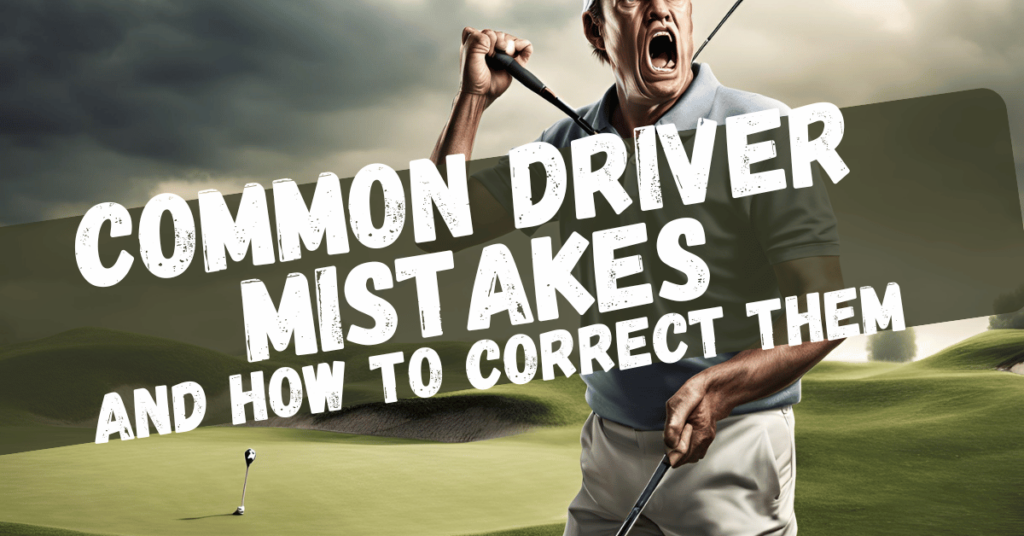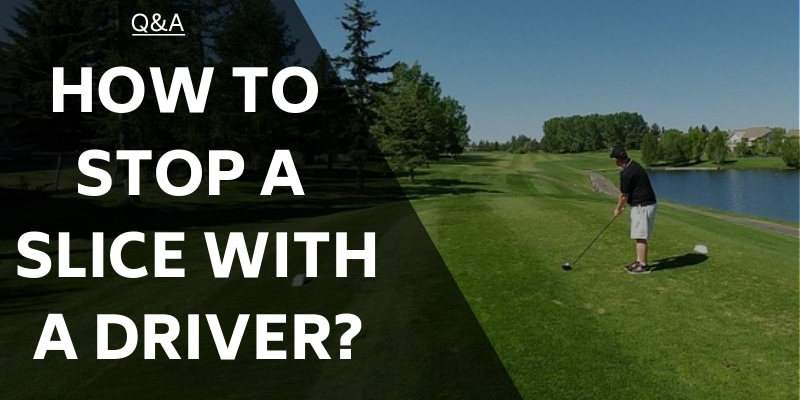On most par four and par five holes, hitting the driver well is very important. This shot sets the stage for playing the rest of the hole. It can be a make-or-break club. With this in mind, I wanted to share with you some of the best tips for driving a golf ball.
The driver is the longest club in the bag. It should be the club you can hit the furthest. The ability to hit the driver well will increase your chances of playing a hole well. Many beginners struggle with the driver. Learning golf driver basics will help you play better golf overall.
The Most Common Driver Mistakes and How to Correct Them
Avoid these mistakes, and you’ll be able to hit more fairways, which means you’ll hit more greens, which means you’ll make more birdies. If you’re struggling with the big stick, address these issues next time you’re at the range and start shooting lower scores. The number one driver mistake all amateurs make is:
Teeing It Too Low
Just because you tee it low doesn’t mean your drives will assume that penetrating flight you’re looking for. Often, it has the opposite effect because when amateurs see a low tee, they instinctively swing steeper to prevent topping the ball. When they swing steeper, the ball gets more backswing, which creates lift and gives the ball more height as it travels.
We don’t want this, so be sure to tee the ball high enough that your driver can comfortably pass through the ball with some space between the sole and the turf. When your club is at rest, you should be able to see half the ball above the crown of the driver. If you can’t see that, tee it higher.
This applies to modern and older golf drivers. It’s also one of the easiest ways to fix your drive.
Uneven Weight Distribution
The second most common driver mistake amongst amateurs is weight distribution. When we see Tiger, Rory, Bryson, and those guys address the ball, they seem to be leaning on their back foot a little bit. This helps them generate power off the back foot as they rotate through. Most of us are not built the same way as those guys, which hinders us from creating the same power.
It’s important for amateurs to keep their weight evenly distributed, or even a bit forward, to prevent the dreaded chunk. When their weight is back, it promotes a club path that swings up instead of through. The swinging up motion causes fat shots or possibly a complete miss altogether. Keep your weight centered so you’re stable through impact and can comfortably follow through.
Related: The 7 Steps of a Proper Golf Swing
Positioning the Ball Wrong
Lastly, amateurs often don’t position the ball forward enough. The driver is by far the longest club in the bag, and it needs extra time to complete a full rotation around your body. To accommodate this extra time, the ball must be positioned forward in the stance, off the front foot. I often see amateurs setting up as if they’re hitting a 5-iron with a neutral ball position.
I know it can be awkward to get used to at first; seeing the ball that far forward is foreign to players the first time they do it. But I would rather see amateurs with the ball positioned too far forward rather than too far back. Less terrible shots will happen when your body is forced to follow through more rather than hang back through the point of impact.
Always line your ball up off your front foot but not so far forward that your shoulders have to open.
Thanks for watching. I’m Clint McCormick, resident golf professional here at Golfspan.com.

25 Golf Driver Tips for Beginners
The following 25 golf driving tips for beginners range from techniques to picking the right driver and golf ball for a beginner and how to practice a golf drive.
1. Use a Neutral Grip For Straighter Drives
Your hands are your only connection to the club itself. Knowing how to correctly hold the driver is a good place to start as a beginner. If you want to hit the ball straight with the driver, your hand placement will directly influence that.
A good neutral grip is what you are looking for as a beginner golfer. This is a grip where the hands are working together. There is a V that is created with your thumb and pointer finger. If you are a right-handed golfer, this is true on both your right and left hand should be pointing over your right shoulder. If you are a left-handed golfer, they should point over your left shoulder.
Pro Tip: Many new golfers grip the club with what is known as a 10-finger, or baseball grip. I advise you to avoid this. The hands need to be connected to each other and work as a unit.

Read More: How To Hit A Driver Consistently – The Ultimate Goal
2. Grip Your Driver Like A Baby Bird
One of the most important tips for driving a golf ball is having the right grip. How hard you grip the club is important. One of the most historic figures in golf, Sam Sneed, said of the grip that “You want to hold the club as if you had a little baby bird in your hands.”
The meaning behind this is you want to grip the club firm enough that it does not fly out of your hands but easy enough that it’s not a death grip.
Pro Tip: Another way to look at grip pressure is on a scale of 1-10, with 1 being barely holding the club and 10 as gripping with all your might. In this example, you want to be at a 4 to 5.
3. Set Feet at Least Shoulder Width Apart
Another of the hitting driver basic is your feet.
You want to get a nice wide base when hitting the driver. You want to have your feet spread at least shoulder-width apart to achieve this.
Pro Tip: I enjoy getting just a little wider than shoulder width. This wide and solid base allows you to be more in balance
4. Slightly Flare Your Feet Out
Rotating your hips and shoulders back in the backswing and through in the downswing is critical for hitting good drives. To help with this, slightly flare your feet out.
How To: To do this, you will want to very slightly turn your front foot towards the target and your back foot away from the target. The front foot should be a little more flared than your back, but neither should be turned all that much.
5. Position the Ball Off of Your Front Heel
Your golf ball should be positioned just off the heel of your front foot. This will allow you to swing a little more up on the ball than you would with all of your other clubs.
How To: To practice this when on the range, use an alignment stick. Place it on the ground, running it off of your front heel toward where you would tee the ball up.
Check this out: How to Teach Golf to a Beginner?
6. Tee the Ball Up Higher
It is common to see beginner golfers tee the ball up far too low with the driver. You need to tease the ball much higher than you might think.
Studies show that teeing the ball up at 1.5” vs. 0.5” increases driver carry distance by just over 14 yards.
Pro Tip: A good rule of thumb is to have the equator of the ball level with the top line of the driver.
7. Bump Your Lead Hip Towards the Fairway in Setup
Sticking with that idea of hitting slightly up on the ball with your driver. You will want to bump your lead hip slightly toward the fairway. Basically, what you are doing when you do that is setting what is called your secondary spine angle in the correct position.
Your primary spine angle is your spine coming towards the ball in setup. Your secondary spine angle is your spine moving away from the target slightly.
8. Set Up With Your Club a Few Inches Behind the Ball
This golf technique for driving will help you achieve proper launch conditions with the driver.
Moving the clubhead back from the ball 2 to 3 inches will make you more likely to swing up on the ball with your driver.
This often not talked about trick has worked wonders with some of my students…and myself!
9. Hover the Driver Off the Ground in Setup
You will occasionally see players on the PGA and LPGA Tour’s doing this. The reasoning behind this is simple. Sometimes, when golfers ground their driver behind the ball in setup, they slightly push the club’s sole into the ground.
Why Is This Important? The first reason is you can snag the club slightly on the ground during the start of your backswing. The second reason is to not ground your driver at set up because you can create tension.
10. Pay Attention to Your Feet in Setup
Your feet play a big role throughout the golf swing. When you get set up with the driver, you want to feel as though your weight, or center of gravity, is positioned correctly. That is not just with your feet but throughout your entire body. That all starts in the feet, however.
You want to feel as though you are centered on the balls of your feet, near the bottom of your laces on your shoes. Not too far back on your heels or too far forward on your toes.
Pro Tip: You also want equal pressure pushing into the ground with your lead and trail foot. Basically a 50-50 distribution.
More from the GolfSpan Blog: How to Drive a Golf Ball Further: A Step-By-Step Guide
11. Chin Up for a Better Shoulder Turn
Before moving into the swing itself, I have one last setup tip. Ensure your chin is up and not buried in your chest in your setup. We often hear “keep your head down,” but the reality is that too much of that, in a literal sense, can restrict your shoulder turn back.
The idea of keeping your head down is more about keeping your head steady and not necessarily down.
12. Take the Club Back Low, Slow, and in One-Piece
As you take the club back in your backswing, you want to feel like the club and arms move back in one piece. The shoulders will be the driver of this one-piece takeaway thought. You want to feel as if the shoulders are turning back, with a steady core, and the arms and club all in line with each other.
You want to take the club back slowly and smoothly. In doing so, you want to take the clubhead back low and refrain from lifting it up.
13. Get Wide With Your Takeaway
Moving on from the initial, one-piece takeaway, you want to continue to rotate back smoothly with the hips and shoulders. You want to get wide as you do so and continue to move back with your hands and the club.
As you stay centered with your sternum and spine and turn back around it, you want to get your hands as far away from your body as possible. This creates width. Good width helps create more speed in your downswing.
14. Rotate Your Hips 45 Degrees
Your hips should rotate around your core about 45 degrees. That is the ideal amount of hip turn. You should strive to turn your hips as much as possible in relation to this suggested amount of turn.
Many beginner golfers do what is referred to as sliding back or swaying. This is a lateral movement of the body, and in this case, the hips. To get a sense of a good hip turn, you want to feel as though your trail hip is moving behind you and your lead hip is moving toward the ball.
15. Rotate Your Shoulders 90 Degrees
Your shoulders need to turn back in the neighborhood of 90 degrees. A good thought for this, to help obtain a good feel for a good shoulder turn, is the idea of getting your back to the target at the top of your backswing.
The key to a powerful driver swing is a good separation between your hips and shoulders. With the turn of your hips, at 45 degrees, versus the turn of your shoulders, at 90 degrees. The 45 degrees of separation between both is what a good “coil” means in the backswing.
16. Proper Downswing Transition and Sequencing
You need to correctly transition down from the top of your backswing to effectively move into the ball at impact. The best way to do that is to understand the correct order of how the body parts are supposed to move in the downswing.
The proper sequence of events from the top of the swing and down starts with the unwinding and turn of the hips into your lead side. Then your upper body follows. Then your hands follow. With the swing only about 1.5 seconds, this happens pretty fast.
17. Swing Towards Your Right
This info is for right-handers. As you come down from the top of the swing, you want to feel like the club is coming from inside or under your swing plane. The best way to get beginners to understand this concept is to feel like you are swinging out to the right or towards first base.
For our lefty friends, just flip that thought.
18. Turn Hips and Shoulders through Impact and Follow-Through
One important tip for beginner golfers wanting to hit great drives is to keep turning your body. Both through impact and follow-through. Many golfers struggle with the body slowing down in its rotation on the downswing, through impact, and through the finish. I often see beginners, and even some better players, letting the arms take over and lead the swing.
In the reverse of the backswing, you want to feel your lead hip moving behind you. Your trail hip will move towards the target. Same deal with your shoulders.
Pro Tip: A great thought to have to keep moving and rotating is to get your belt buckle or belly button to the target, followed by your chest.
19. Treat The Back Of Your Lead Hand as the Clubface
The lead wrist and hand play a big role in hitting straight shots with the driver, or any club for that matter. You want to think of the back of your lead hand as being the clubface. Where it goes, your clubface goes.
You want to have the back of that lead hand flat and facing the target at impact. Many golfers tend to get that lead wrist “cupped” or extended. This adds loft and also does not allow the clubface to be square at impact.
20. Release Your Hands Toward the Target
Releasing the club is a feeling of throwing the club towards your target. At about 45 degrees past impact, your arms and the club shaft should be in line.
At that point, you should feel like you are throwing the club toward the target as you continue to turn to your finish.
21. Hold a Good Solid, Balanced Finish
This tip is simple yet highly effective. Holding a solid, balanced finish helps solidify a good swing overall. It does not guarantee it, but it absolutely helps.
22. Work on Your Fitness for Better Drives
A golfer’s ability to hit great drives heavily depends on moving their body well. Working on your flexibility more so than strength is key.
One great flexibility workout from my good friend, Scott Shepard, can be seen here. Scott is a two-time Golf Digest Top 50 Fitness Instructor.
What you need: PVC or wooden dowel rod or your golf club.
Torso Rotations
Torso Rotations: Stand with your feet shoulder-width apart and hold a PVC or golf club behind your shoulders. Slowly rotate your torso to the left and right, keeping your feet planted firmly on the ground. Do 10 to 12 rotations on each side.
Hip Post Stretch
Hip Post Stretch: Stand with your feet together and take a big step forward with your left foot. Bend your left knee and place your right hand on your left knee for support. Reach your left arm up and over your head, stretching your torso and hips. Hold for 10 to 15 seconds, then switch sides and repeat.
Read more: The Best Golf Workouts
23. Choose The Right Driver and Ball
Things to consider with a driver include the head of the club and the shaft. The shaft is important. You need to play a shaft that matches up with your swing speed. Golfers often buy a club off the shelf, which isn’t right for them. The thing with beginners is that they simply don’t know.
In terms of the golf ball, most beginner golfers need a ball that is more about distance and reducing side spin. Look for a Surlyn, 2 or 3-piece ball.
24. How To Practice Your Drives
One of the best driving practice tips for beginners is picking targets.
With your driver on the range, you must pick targets that will define your fairway’s left and right sides. You will set a center target in between those left and right barriers.
As you hit balls, do so in sets of 10 drives. Set a goal for the number of drives out of those 10 that you want to hit the fairway.
Make sure you go through your normal pre-shot routine on each shot. If you do not have a pre-shot routine, you need to create one.
Read on: The 10 Best Drivers for Beginners
25. Practicing for Speed with Your Driver
Creating more speed is necessary to hit the ball further. The first part of creating more speed comes with learning proper technique. The previous tips will help with that.
Beyond that, you can turn to a multitude of swing speed training aids that exist in the marketplace. One of those that I love is Aero-Swing. This is a resistance trainer. Through air resistance, you can help build up speed.
Read on: The Best Golf Balls for High Handicappers
Biggest Beginner Mistakes to Avoid with Your Driver
After considering driving tips for beginners in golf, there’s a big thing to consider: avoiding mistakes. Here are a few of the biggest mistakes I see beginners make when it comes to hitting the driver:
Too Wide of a Stance
While it’s true that you want a good wide base in setup, getting too wide in your stance will limit your ability to rotate. Make sure you are shoulder width apart with your feet or just slightly wider.
Bad Ball Position
Many beginners play the ball too far back in their stance. This limits the ability to swing slightly up on the ball at impact. Shots come off too low, and you cannot maximize your ability when the ball is too far back.
Trying to Help the Ball Up Too Much
While we want to swing slightly up on the ball with the driver, I see many golfers doing this improperly. The most common fault here is getting the hands to “flippy” at impact. This is when that lead wrist is not flat as you come into impact.
Little to No Body Rotation
It is common for beginners to use more arms, pick the club up, and swing the arms through without body rotation. The rotation of the hips and shoulders and the resistance between the turns in both is critical.
Improper Speed Application
Speed in the golf swing must be built up slowly as you return and then gradually increase through impact.
Many beginners take the club back far too fast in the backswing. This is a power drain right out of the gate. Others try to hit the ball hard from the top of the swing. This gets the hands out of sequence and again leads to a power leak.
In Summary
Hitting the driver straight and long is a goal every golfer has. So much so if you go to any driving range right now, most golfers will be hitting the driver. It’s inevitable.
When a golfer is new to the game, that is the time to really invest in learning the proper techniques for hitting the driver.
Hopefully, these golf driver tips for beginners will help you hit some amazing drives!








